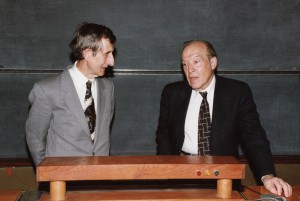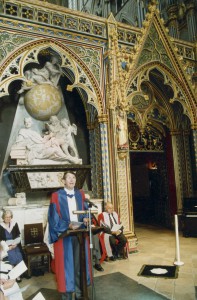December 10, 2014, by Kathryn Summerwill
Nobel prizewinner at The University of Nottingham
Today’s glittering ceremony in Oslo honours the Nobel prizewinners of 2014. Unfortunately, none of them are from our University this year, although in 2004 Nottingham alumni were awarded two Nobel awards: the Nobel Prize for Medicine was given to Sir Peter Mansfield for his pioneering work in Magnetic Resonance Imaging, and an additional Nobel Prize for Economic Science to a Nottingham graduate and former member of staff, Professor Clive Granger.

Julian Schwinger and Freeman Dyson at the Bicentenary celebrations, Nottingham, 1993
From GG 7/5/10/1
This blog’s rather misleading title refers instead to the visit of Professor Julian Schwinger to Nottingham in July 1993, and the events of that week which commemorated the bicentenary of the birth of the Nottingham mathematician George Green (1793-1841).
Julian Schwinger (1918-1994), an American theoretical physicist, was jointly awarded the Nobel Prize in Physics in 1965 for his work on quantum electrodynamics (QED), along with Richard Feynman and Shinichiro Tomonaga. His work built on and used the tools created by George Green in his 1828 Essay on the Application of Mathematical Analysis to the Theories of Electricity and Magnetism. On the suggestion of Professor Lawrie Challis of the School of Physics, who was also Chairman of the George Green Memorial Fund and organiser of the bicentenary events, The University of Nottingham invited Schwinger to vist and give a public lecture. The other speaker, Freeman Dyson (1923-), worked in the same sphere of physics, and in the 1940s proved the equivalence of Feynman’s diagrams and Schwinger and Tomonaga’s operator method in formulating quantum electrodynamics.
Schwinger and Dyson are pictured at the Physics Department Lecture Theatre on Wednesday 16 July 1993. Schwinger’s talk – which was most likely his last public appearance – was entitled “The Greening of Quantum Field Theory: George & I”, and Dyson’s “Homage to George Green: How Physics Looked in the Nineteen-Forties”. Both lectures were published in the Nottingham University Gazette in 1993. A copy is in the George Green collection (GG 3/30), and can be seen in the Manuscripts and Special Collections Reading Room at King’s Meadow Campus. They were also published by D.M. Cannell in the 2001 edition of her biography, George Green, mathematician & physicist, 1793-1841 : the background to his life and work. This book is available for loan at George Green Library and at King’s Meadow.
After the lectures, Schwinger and Dyson were present at the official re-naming of the Science and Engineering Library after George Green. The following day they were both presented with Honorary Degrees from the University of Nottingham.
On Friday 16 July, the George Green bicentenary celebrations moved to London. George Green was honoured with the unveiling of a memorial plaque in Westminster Abbey, in a prominent position under the monument to Isaac Newton. Green’s plaque is appropriately placed near to the memorials to the 19th-century scientists Kelvin, Faraday and Clerk Maxwell, whose work built on Green’s foundations.
The image shows Professor Lawrie Challis giving an address at the service in which the plaque was unveiled. The service was attended by Julian Schwinger and a host of other important guests including Mr Clive Foxell, President of the Institute of Physics, Professor John Ringrose, President of the London Mathematical Society, John Fauvel, President of the British Society for the History of Mathematics, Sir Michael Atiyah, President of the Royal Society, Professor Michael Rycroft, President of the Institute of Mathematics and Its Applications, and Professor Sir Sam Edwards, Cavendish Professor of Cambridge and President of Caius College. Official photographs at Westminster Abbey were taken by Andrew Dunsmore/Picture Partnership.
More information about George Green and his significance can be seen at Manuscripts and Special Collections’ exhibition George Green: Nottingham’s Magnificent Mathematician, which is open at the Weston Gallery at Nottingham Lakeside Arts until Sunday 4 January 2015.
No comments yet, fill out a comment to be the first


Leave a Reply